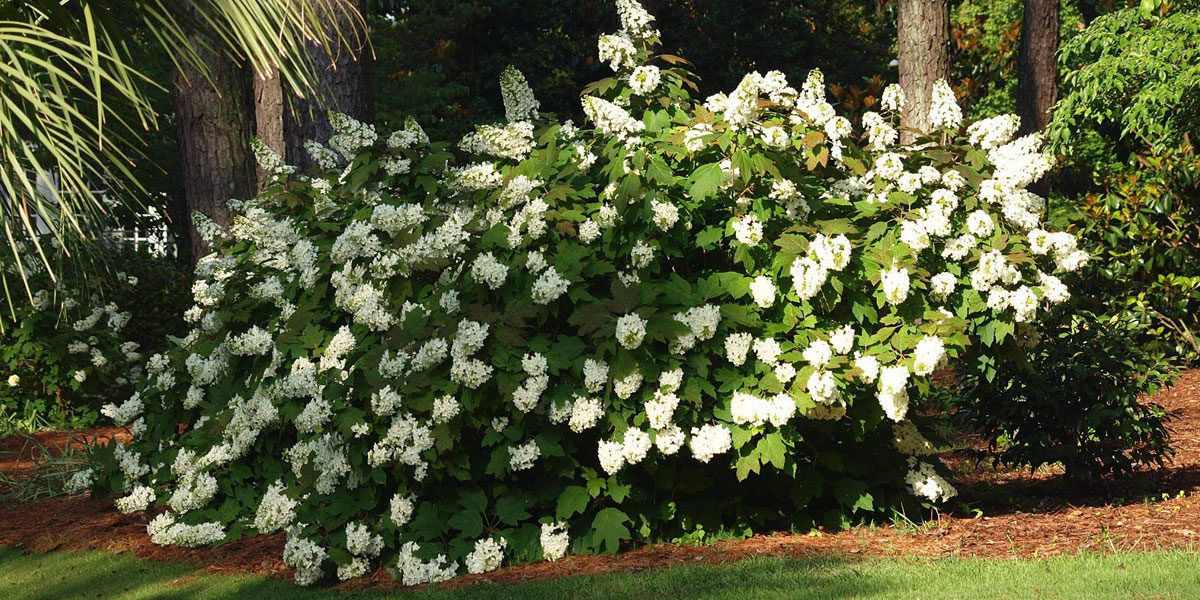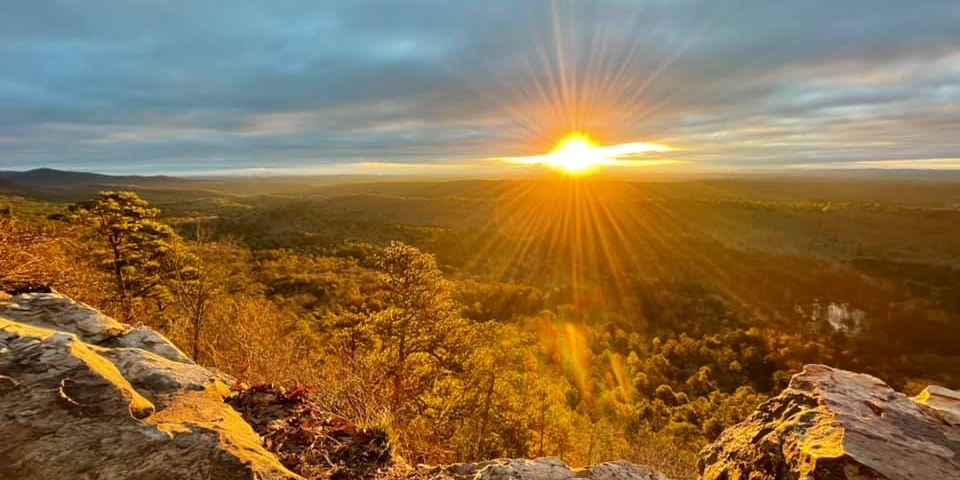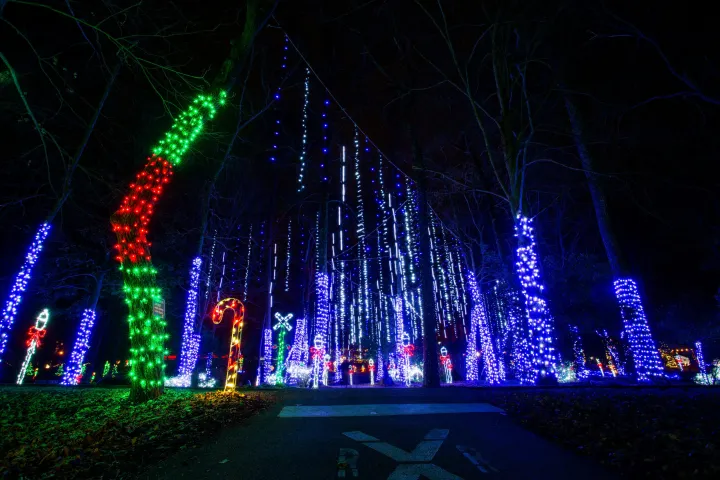Summer may turn a wildflower hike into a sauna, but there are plenty of creeks, caves, swimming holes and natural phenomena to make working up a sweat worthwhile. Our famed hydrangeas are in full bloom in every variety from climbing to giant foot-long blooms. Creature features include the largest emergence of bats east of the Mississippi and a glowworm only seen here and Down Under. Alabama is a natural paradise, ranked as number four in biodiversity in the United States. Much of this diversity is due to our five geologic regions. Alabama is a special place for the explorer willing to seek its charms. Here are 10 nature experiences to add to your list this summer.
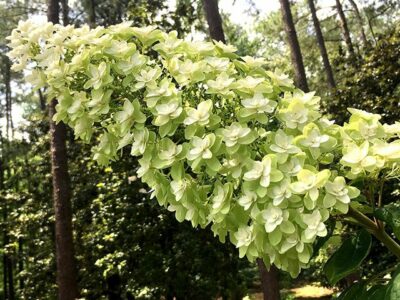
(Aldridge Gardens/Facebook)
Admire Hydrangeas at Aldridge Gardens
Hydrangeas come in more than white, pink, and blue. You can also find purple, burgundy, and orange. Eddie Aldridge scoured the woods and gardens of Alabama to find unusual varieties of hydrangeas. His most famous discovery was the Snowflake Hydrangea, with its white, double bloom. More than 50 varieties of hydrangea dot the walking paths of the personal garden the Aldridges gifted to the City of Hoover. These blooms show-off in early summer, but retain blooms steadily, drying into intriguing colors as they fade. Alabama is hydrangea-central with more types and numbers of hydrangeas than anywhere else in the world. A wildflower garden in the back grows sunflowers, Joe Pye Weed, ironweed and
Turkey Creek Nature Preserve
After you admire the many wildflowers in bloom: coneflower, rosinweed, butterfly weed, blazing star and white buckeye, the waters will call to you. The swimming residents of Turkey Creek require pure water for their survival. The colorful Vermillion Darter’s only home in the world is the cascading waters of the creek. The creek hosts seven protected species, making it one of the most biodiverse areas in the country. The hiking trails lead you through historic Native American and iron-making sites along with lush flora. After you explore, take a dip in a real swimming hole. Blue Hole offers the vintage childhood experience of plunging into a clear, clean natural pool. The Falls features a natural waterslide down the rocks into the fresh water.
Take a Moonlight Guided Canoe Tour
The sound of owls hooting in the night. The sash of moonlight trailing through the gentle waves. Frogs singing in the trees and ponds. The soft sound of paddles pushing water behind them. With any luck and depending on where you put in, you may spy the flash of red of an Indian Paintbrush. The Cahaba River Society provides everything you need to enjoy a romantic (even if it’s only a love of nature) evening on the river. You may even see Dismalites turning on their blue-green illumination on scattered boulders. The guide will point out wildlife, seen and heard. The sycamore, willow, sweet gums and water oaks drape over the water. Beginners can enjoy this easy paddle.
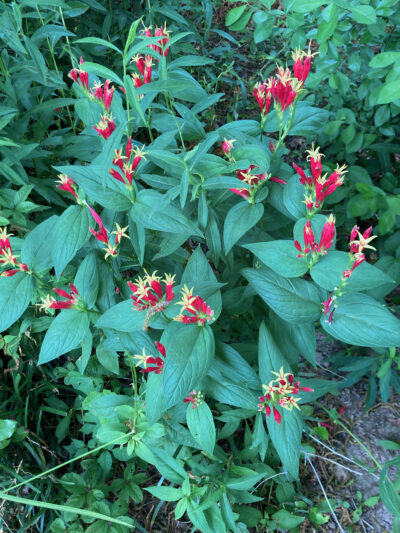
Indian Pinks (Verna Gates/Contributed)
Search for shark teeth at Shark Tooth Creek
Water willow leads you down the path to find treasures. Indian Pinks lean in to see what you may find. Ancient Alabama was underwater and giant sea creatures swam over much of the state. They left evidence of their presences in the form of shark teeth. In Aliceville, all that remains of this grand ocean is a shallow creek where thousands of sharks’ teeth have been found by paleontologists and children. Experts conjecture that the area was once a barrier island, like its modern-day cousin, Dauphin Island. Shark teeth are not attached to the gum, like humans, and they generally shed a tooth a week. The lemon shark may discard as many as 30,000 teeth in a lifetime. The teeth found here originated in the mouths of 16 different species of ancient sharks.
See bats at Sauta Cave National Wildlife Refuge
As you travel along Highway 72 near Scottsboro, keep a sharp lookout for mile marker 131. Pull over on that small side road that leads to Sauta Cave, which used to be called Blowing Wind Cave. You may notice a distinct lack of mosquitos as you traverse the path at the biting-bug prime time of dusk. A sign leads down to a platform facing the cave entrance. A cool breeze emerging from the mouth brings welcome relief to the hot day. Soon, you will see one or two bats, including rare gray and Indiana bats, which are protected by the cage blocking the entrance. In the largest emergence of bats east of the Mississippi, more than 400,000 bats will fly above you, swirling like a dark cloud in frenzied motion. Be grateful for these bats, as they can eat their weight in mosquitoes and other bugs every night. Along the path to the cave, you will find black-eyed Susans, spiderworts, rosinweed, and partridge pea.
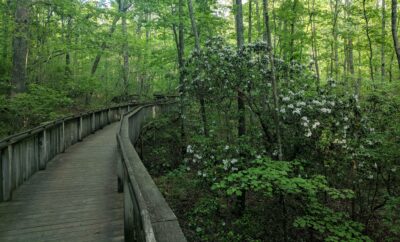
(DeSoto State Park~Fort Payne, Alabama/Facebook)
Marvel Big Leaf Magnolias at Desoto State Park
Our native magnolia tree grows large, soft leaves that can range from one to three feet long. These whoppers form a circle, resembling a canopy over the tree. They look like palm trees in the forest. Except for one thing: a huge, white flower that spans nearly a foot across. The giant bloom sits above the leaves and issues a sweet scent that roams far beyond the tree. Desoto State Park is filled with these trees along its Boardwalk Trail. An easy path, it circles around and across the creek. Some of the walk is raised, giving you a clear view down onto many of the blooms.
See Black Belt Flowers and Birds
The patches of yellow and purple slash across flat fields of flowers, punctuated by the flash of red or blue or yellow of a flickering bird dipping down for a tasty bug. The Alabama Black Belt is home to prairie grasses such as big and little blue-stem, which color coordinates with a purple clover. There are unusual sun-loving wildflowers, such as prairie rosinweed, prairie coneflower, and golden asters, that typically make their home in the Great Plains, and are not expected in the Camelia State. These remnants remind us of what was here before cotton was king. These long stretches of grasses are home to thousands of animals, including birds. The weekend of July 29–30, birders will congregate in the city of Greensboro to enjoy the birds and the prairie in bloom. Join Alabama Audubon for this event. other colorful natives.
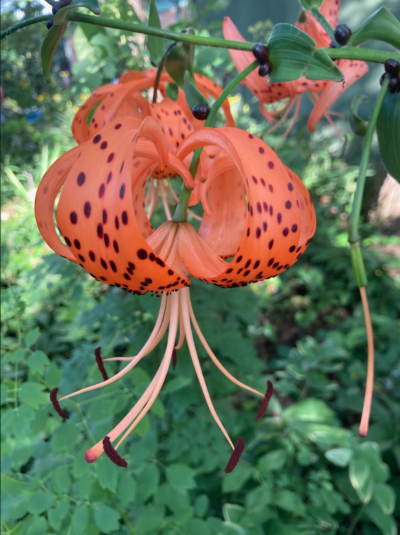
Tiger lily (Verna Gates/Contributed)
Paddle Bear Creek Canoe Trail
In so many places, the summer water levels can shrink so low that canoeing becomes a walk with a boat. Bear Creek is fed by dam releases, making it the only sure bet for a good ride in sufficient water. The lazy creek can be paddled fast, or cruise along for a gentle ride. Novices and families with kids can safely traverse the watery path while observing summer flora along the rich banks. Several sand bars call for a picnic and shell search. There is a morning and evening run on two different sections. An overachiever can make both in a day, or take two days adding a visit to the nearby Dismals Canyon. Along the way, you will see wild white hydrangeas blooming along with Indian Pinks, orange butterfly weeds, cardinal flower, spiderworts, and hopefully, a tiger lily. The creek is located near Hackleburg.
Climb through Caves and Caverns
Caves and caverns feature walking paths with native flora adding color with blooms and butterflies. Hibiscus, Indian Pink, blue sage, and hydrangeas line the trails. Butterflies flutter over the milkweed. Alabama is a mecca for caves, which maintain a temperature between 55 and 60 degrees. Caves literally are a cool place to go in the heat of summer. Desoto Caverns has created its own entertainment district with everything from a squirt gun lost trail to hula hoops. Inside, the show includes special effects along with history facts. Cathedral Caverns offers hiking trails to explore before you cool off inside. The giant entrance to this cave gives way to “Goliath,” measuring 45 feet tall and 243 feet around, making it one of the biggest stalagmites in the world. Rickwood Caverns tours take you 175 feet below the earth into what was once an ocean bed. See the miracles water can carve in its twists, turns, and shapes.
Cruise to see Lotus Blooms
In summer, the Mobile-Tensaw Delta is brimming with yellow lotus flowers. They bob in the waters, tossing their thick fragrance up onto the banks for your senses to embrace. By the thousands, they float on the waters all along the riverways. One way to see them is to take one of the cruises leaving from Blakeley State Park and Gulf Shores. Wild Native offers a variety of tours from pontoon to canoe tours of wildlife and wildflowers. If you time it right, you can make Shark Week at Gulf State Park, but you might not want to go in the water!
For information on exploring outdoor Alabama, visit FreshAirFamily.org.
(Courtesy of SoulGrown)




